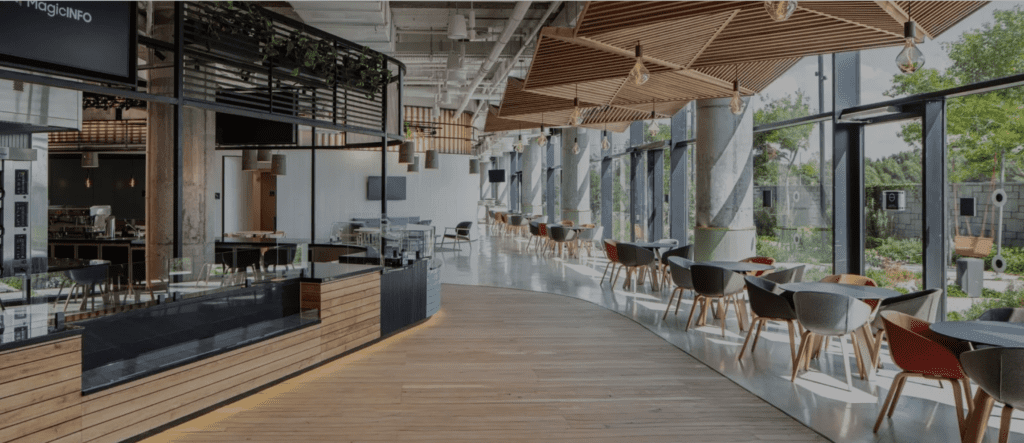As companies around the world take action on their sustainability commitments and net zero commissions, offices are turning greener. The trend of the adoption of green building standards and certifications is on the rise.
Some office buildings use energy-conserving glass, some recycle wastewater, and others build microclimates that suit their employees’ preferences. These sustainable actions are essential for companies to meet their green goals. Beyond this, sustainability adoption also allows companies to attract and retain environment-conscious employees. Today’s employees want actions on sustainability and they prefer employers who favor and adopt sustainable practices. This stands true, especially for the younger generation.
Now comes the big question – How to bring sustainability into the workplace?
We are here to solve this conundrum for you! Here are 5 easy-to-implement ways through which you can make your office greener and adopt sustainability –
- Go big on renewable energy:
You will agree with us when we say green sources of power, including wind energy and solar energy, are more accessible in present times than ever. Companies today can easily take advantage of options like rooftop solar panel installations and make an easy switch to renewable energy. Not much of an uphill battle plus using renewable energy can significantly reduce the carbon footprint of your company.
- Bring the outside inside:
Did you know the incorporation of natural elements in the office like natural lighting, green walls, indoor plants, and ventilation, can improve the general well-being of the employees? It helps reduce stress, increase their attention spans, and further reduces the energy costs of the company.
Natural light, open spaces, and communion with nature lead to positivity in the workplace. If the figures are to be believed, the integration of natural lighting in indoor office spaces can reduce the need for artificial lighting and potentially cut energy costs by nearly 80 percent.
In addition to this, you can also bring indoor plants into the office spaces to improve the entire aesthetic of the office and indoor air quality. Indoor plants also have the same effect on workplace productivity and employees’ well-being as natural light.
Here is an example of an office that took the green theme seriously-

Citibank’s Wealth Hub office in Singapore is designed on the theme of a banking conservatory. They have replaced the conventional meeting rooms with garden meeting pods nestled in between shrubs and lush greenery.
- It’s the age of going paperless:
As we move towards digitization, the use of paper has reduced substantially. In order to meet their sustainability goals, companies are going paperless. Making this transition is relatively easy as companies anyways maintain their databases online and share the majority of their documents over email. You too can initiate baby steps towards a paperless workplace by cutting down the use of paper. This can reduce your print-related costs, paper-related clutter, and slows down deforestation.
Still, some companies rely on paper use to a minor degree for agendas, invoices, and important documentation. These companies can choose to be sustainable by replacing the use of virgin paper with recyclable paper. This cost-effective practice can reduce our environmental footprint.
- Take the help of your smart friends – IoT and A.I.:
The technology of Artificial Intelligence and the Internet of Things can help in energy conservation and increase the efficiency of your efforts in that direction.
Let’s understand how –
Consider an example of BeeBryte. BeeBryte is an energy intelligence and automation firm. It takes the help of AI and IoT technology to predict the thermal needs of the office building based on factors like occupancy and weather conditions. It uses this information to adjust the heating, ventilation, and air conditioning of the building automatically in real time. This keeps the temperature of the building within predetermined ranges and saves up to 40 percent of the energy costs.
Today buildings have a variety of systems for functions like measuring indoor air quality levels, air temperature, and space occupancy. This creates a significant amount of data and companies can process this data and analyze it to make more efficient and sustainable decisions.
- Recycle, Reuse & Reduce –
The trend of recycling wastewater in office buildings has picked up the pace.
Did you know?
The Salesforce Tower in San Francisco recycles around 1,13,562 liters of dirty water that is used by the building, filters it, and returns it as clean water safe for use in toilets.
Offices worldwide can adopt this practice of wastewater recycling and reduce their environmental footprints. They can also extend the practice of recycling to paper, plastic, glass, and metals.
Another easy-to-implement sustainable practice is the use of reusable products, especially for dining in the office. Offices can also create dedicated spaces where employees can share their surplus equipment and supplies.
Embracing sustainability in the office benefits the three big Es – Employer, Employees, and the Environment. The trend of turning sustainable is here to stay for a long time now and offices should start adopting it to reduce their carbon footprints.

